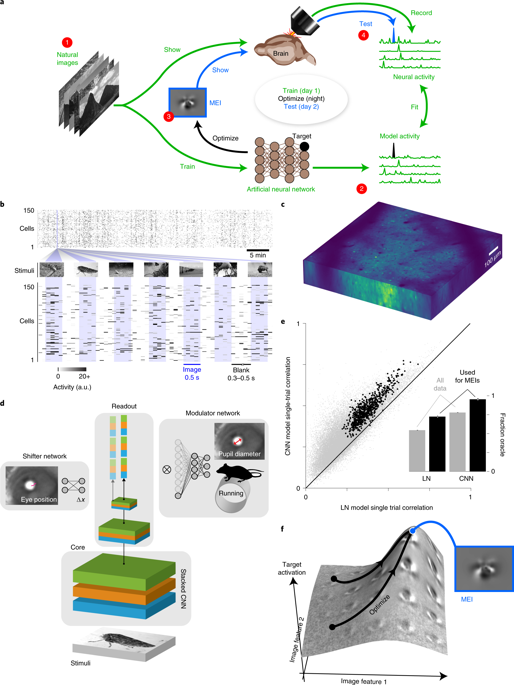当前位置:
X-MOL 学术
›
Nat. Neurosci.
›
论文详情
Our official English website, www.x-mol.net, welcomes your
feedback! (Note: you will need to create a separate account there.)
Inception loops discover what excites neurons most using deep predictive models.
Nature Neuroscience ( IF 21.2 ) Pub Date : 2019-11-04 , DOI: 10.1038/s41593-019-0517-x Edgar Y Walker 1, 2 , Fabian H Sinz 1, 2, 3, 4 , Erick Cobos 1, 2 , Taliah Muhammad 1, 2 , Emmanouil Froudarakis 1, 2 , Paul G Fahey 1, 2 , Alexander S Ecker 1, 3, 5, 6 , Jacob Reimer 1, 2 , Xaq Pitkow 1, 2, 7 , Andreas S Tolias 1, 2, 7
Nature Neuroscience ( IF 21.2 ) Pub Date : 2019-11-04 , DOI: 10.1038/s41593-019-0517-x Edgar Y Walker 1, 2 , Fabian H Sinz 1, 2, 3, 4 , Erick Cobos 1, 2 , Taliah Muhammad 1, 2 , Emmanouil Froudarakis 1, 2 , Paul G Fahey 1, 2 , Alexander S Ecker 1, 3, 5, 6 , Jacob Reimer 1, 2 , Xaq Pitkow 1, 2, 7 , Andreas S Tolias 1, 2, 7
Affiliation

|
Finding sensory stimuli that drive neurons optimally is central to understanding information processing in the brain. However, optimizing sensory input is difficult due to the predominantly nonlinear nature of sensory processing and high dimensionality of the input. We developed 'inception loops', a closed-loop experimental paradigm combining in vivo recordings from thousands of neurons with in silico nonlinear response modeling. Our end-to-end trained, deep-learning-based model predicted thousands of neuronal responses to arbitrary, new natural input with high accuracy and was used to synthesize optimal stimuli-most exciting inputs (MEIs). For mouse primary visual cortex (V1), MEIs exhibited complex spatial features that occurred frequently in natural scenes but deviated strikingly from the common notion that Gabor-like stimuli are optimal for V1. When presented back to the same neurons in vivo, MEIs drove responses significantly better than control stimuli. Inception loops represent a widely applicable technique for dissecting the neural mechanisms of sensation.
中文翻译:

初始循环使用深度预测模型发现最能激发神经元的因素。
寻找最佳驱动神经元的感觉刺激对于理解大脑信息处理至关重要。然而,由于感觉处理的非线性性质和输入的高维性,优化感觉输入很困难。我们开发了“初始循环”,这是一种闭环实验范式,将数千个神经元的体内记录与计算机非线性响应模型相结合。我们的端到端训练的、基于深度学习的模型以高精度预测了数千个神经元对任意新自然输入的反应,并用于合成最佳刺激——最令人兴奋的输入(MEI)。对于小鼠初级视觉皮层 (V1),MEIs 表现出复杂的空间特征,这些特征在自然场景中经常出现,但与 Gabor 样刺激最适合 V1 的普遍观念截然不同。当在体内返回到相同的神经元时,MEIs 驱动的反应明显好于对照刺激。初始循环代表了一种广泛适用的技术,用于剖析感觉的神经机制。
更新日期:2019-11-04
中文翻译:

初始循环使用深度预测模型发现最能激发神经元的因素。
寻找最佳驱动神经元的感觉刺激对于理解大脑信息处理至关重要。然而,由于感觉处理的非线性性质和输入的高维性,优化感觉输入很困难。我们开发了“初始循环”,这是一种闭环实验范式,将数千个神经元的体内记录与计算机非线性响应模型相结合。我们的端到端训练的、基于深度学习的模型以高精度预测了数千个神经元对任意新自然输入的反应,并用于合成最佳刺激——最令人兴奋的输入(MEI)。对于小鼠初级视觉皮层 (V1),MEIs 表现出复杂的空间特征,这些特征在自然场景中经常出现,但与 Gabor 样刺激最适合 V1 的普遍观念截然不同。当在体内返回到相同的神经元时,MEIs 驱动的反应明显好于对照刺激。初始循环代表了一种广泛适用的技术,用于剖析感觉的神经机制。









































 京公网安备 11010802027423号
京公网安备 11010802027423号